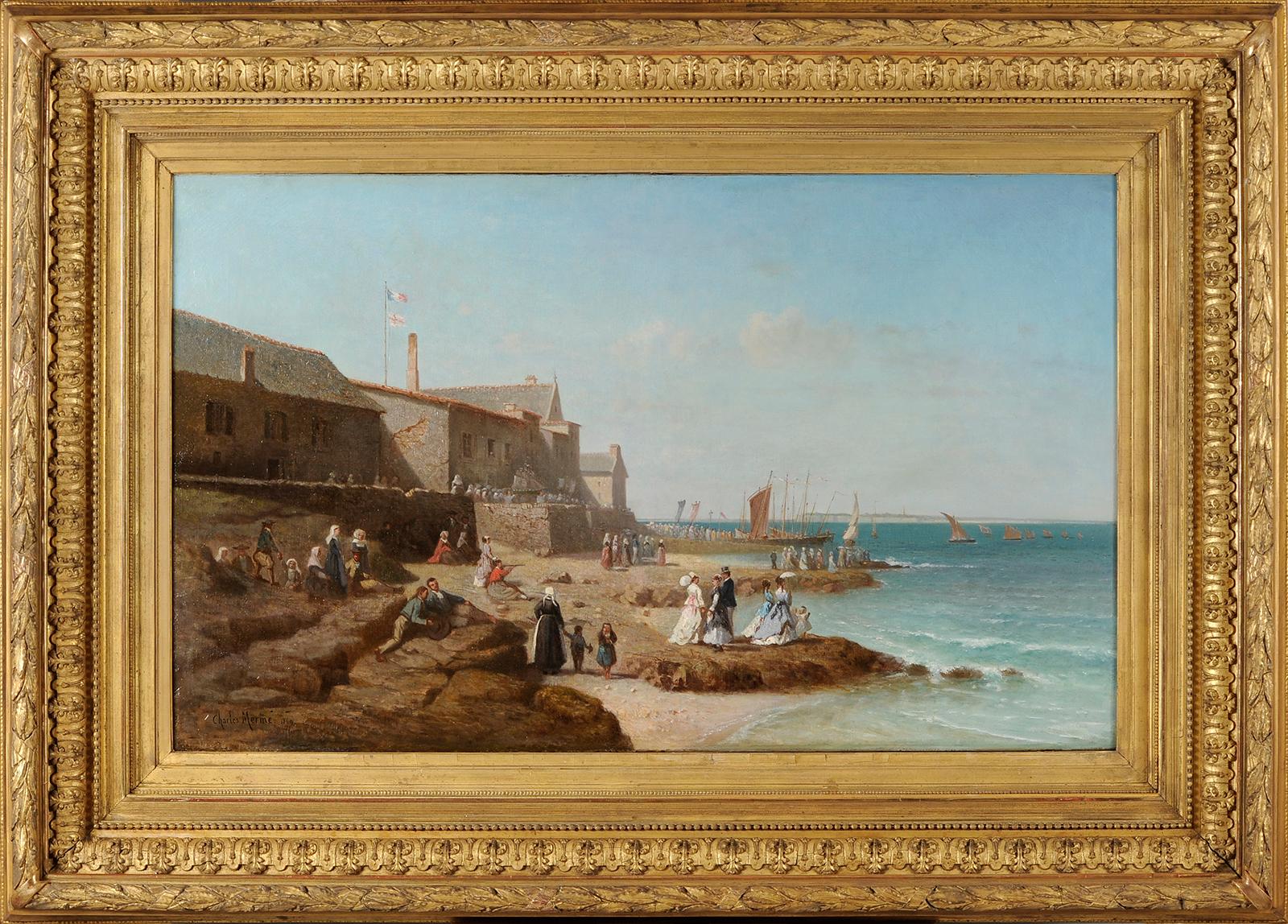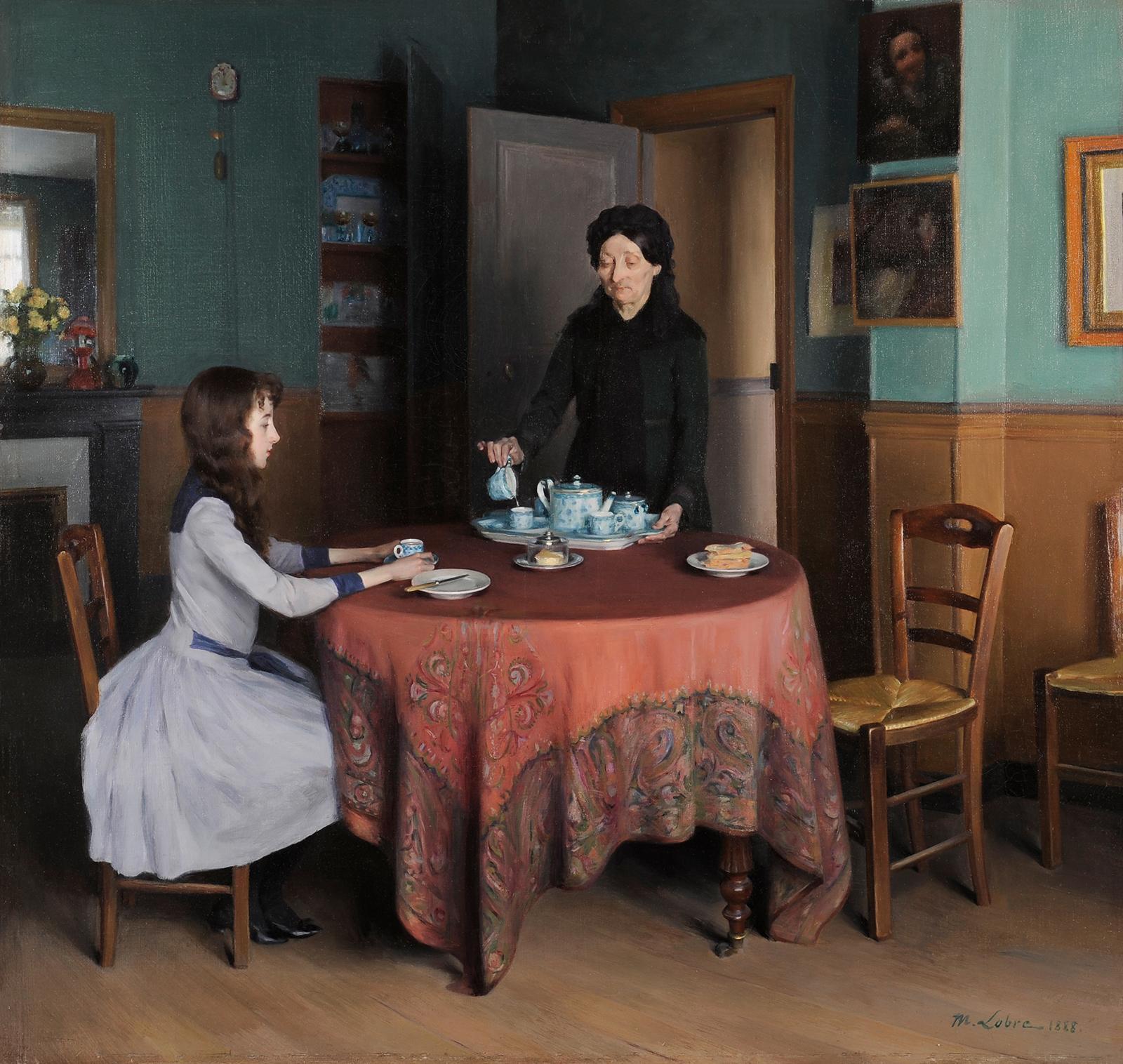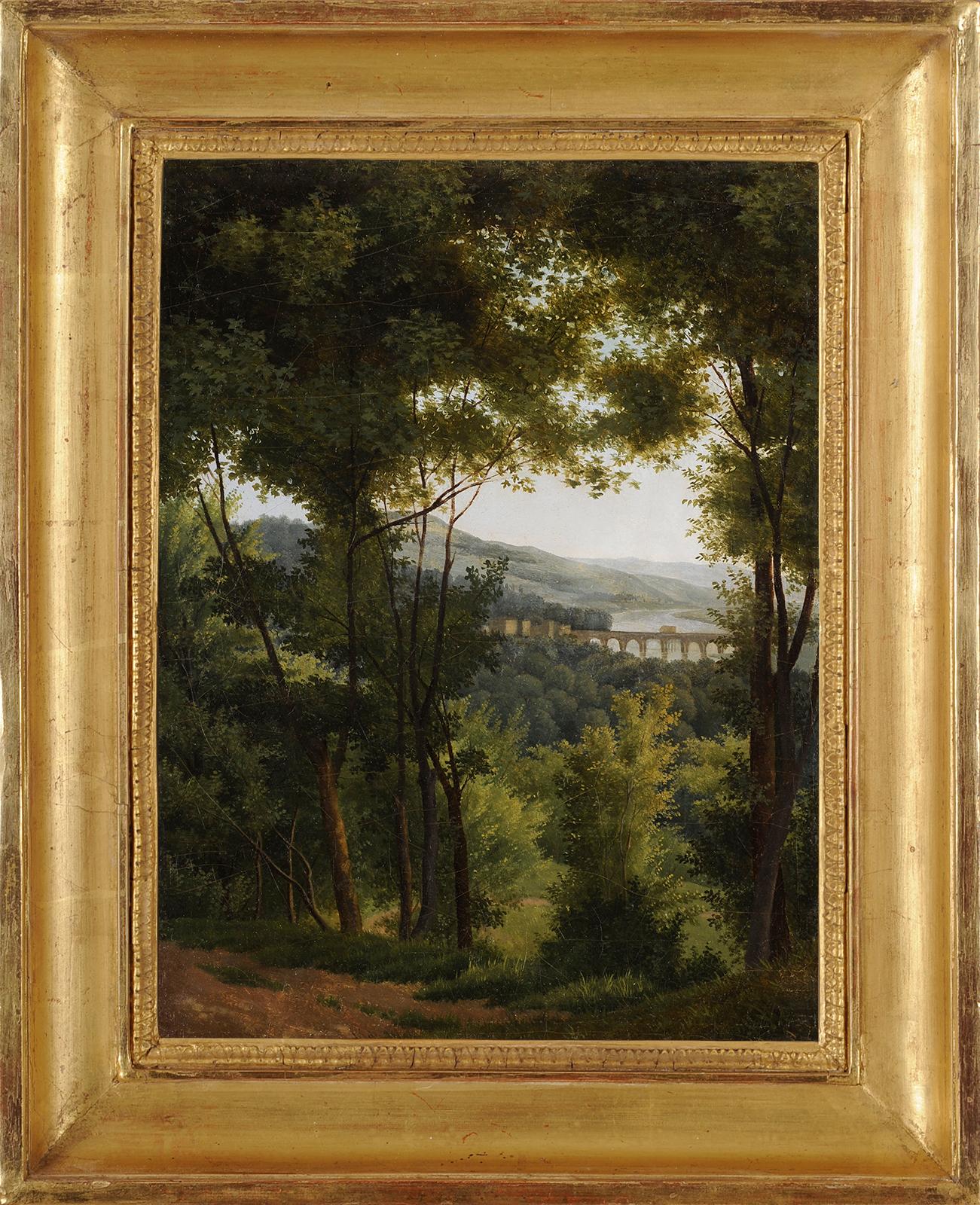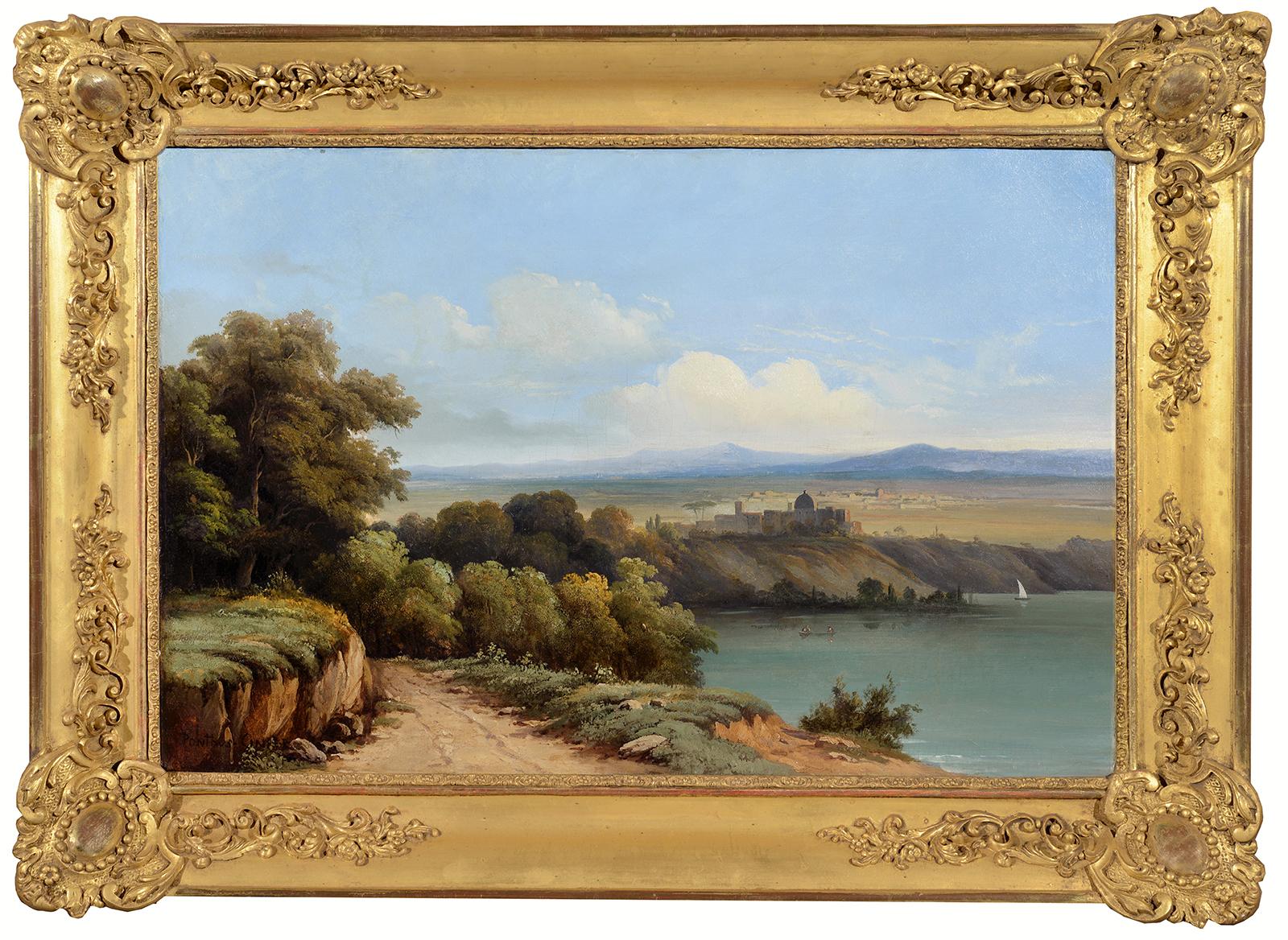Frederick RondelBean Picking, New Jersey, 18901890
1890
About the Item
- Creator:Frederick Rondel (1826-1892, American)
- Creation Year:1890
- Dimensions:Height: 21.5 in (54.61 cm)Width: 35.5 in (90.17 cm)
- Medium:
- Movement & Style:
- Period:
- Condition:
- Gallery Location:Missouri, MO
- Reference Number:1stDibs: LU747310900922
Frederick Rondel
Frederick Rondel was a well-known and prolific painter of American landscapes, as well as a teacher of numerous artists, both male and female. Rondel worked in New England, especially in the Newport area as well as the Hudson River Valley and as far south as Richmond, Virginia. He was proficient in oil and watercolor painting and specialized in atmospherically-rendered landscape and marine pictures and figurative subjects. Born in Paris in 1826, Rondel began his art career as a student initially under the direction of Théodore Gudin and then, Auguste Jugelet, both romantic marine and landscape painters. In 1855, Rondel arrived in the United States, and began his American art career in Boston, before moving to South Malden, Massachusetts in 1858. He simultaneously maintained a studio in New York City as well. In 1860, Rondel decided to reside permanently in New York City, soon becoming an associate member of the prestigious National Academy of Design. To broaden his training, Rondel traveled to Europe, staying for six years before returning to the United States in 1868 to accept a teaching position at the National Academy. At the National Academy, Rondel’s most famous student was Winslow Homer. Homer attended the National Academy early in his career and took painting classes with Rondel, who is attributed with teaching him how to use oils. French by birth and artistic training, Rondel is considered one of the top American painters. He skillfully combines broad, deep perspective with clear, subtle light and his landscapes and marine paintings reflect the romanticism of Gudin and Jugelet. Most importantly the subjects of his paintings are distinctly American; including portraits, animals, New York City and the New England countryside.
- ShippingRetrieving quote...Ships From: Missouri, MO
- Return PolicyA return for this item may be initiated within 2 days of delivery.
- Central Park AutumnBy Paul CornoyerLocated in Missouri, MOPaul Cornoyer “Central Park Autumn” c. 1910 Oil on Canvas Framed Size: approx 29 x 35 inches Canvas Size: approx 22 x 26.5 inches Provenance: The Artist to Private Collection, St. Louis thence by Descent Conservation report: Excellent condition. On original canvas, not relined. No in-painting. Paul Cornoyer was born in 1864 in St. Louis, Missouri. He studied there at the School of Fine Arts in 1881. His first works were in a Barbizon mode, and his first exhibit was in 1887. In 1889, he went to Paris for further training, studying at the Academie Julien, and returned to St. Louis in 1894. By the early 1890s, his work was more lyrical and Tonal, and he applied this style to subjects such as cityscapes and landscapes. In 1894, he painted a mural depicting the birth of St. Louis for the Planters Hotel in that city. His activities during the next six years were not particularly profitable, however, and the whereabouts of his St. Louis paintings are scarcely known. One exception is the triptych, A View of Saint Louis, with its strong urban realism. It shows the Eads Bridge...Category
1910s American Impressionist Figurative Paintings
MaterialsOil, Canvas
- The Signing of the Winfield Scott TreatyBy Benton ClarkLocated in Missouri, MOBenton Clark (American, 1895-1964) The Signing of the Winfield Scott Treaty Signed Lower Right 24 x 36 inches 31.5 x 43.5 inches with frame Born in Coshocton, Ohio, Benton Clark bec...Category
20th Century American Realist Figurative Paintings
MaterialsOil, Canvas
- Afternoon, Madison SquareBy Paul CornoyerLocated in Missouri, MOPaul Cornoyer (American, 1864-1923) "Afternoon, Madison Square" (New York City) 1908 Oil on Canvas Signed/Titled Verso on Stretcher Bar Unframed: 22 x 27 inches Framed: 32.5 x 38 inches Exhibition Label Verso (Presumably Newhouse Galleries, St. Louis...Category
Early 1900s Tonalist Landscape Paintings
MaterialsOil, Canvas
- Mid-day, Zuni VillageBy Frank Reed WhitesideLocated in Missouri, MOMid-day, Zuni Village, 1897 By. Frank Reed Whiteside (American, 1866-1929) Unframed: 20" x 30" Framed: 28" x 38" Frank Reed Whiteside, born in Philadelphia on 20 August 1867, became a student of Thomas Anshutz at the Pennsylvania Academy of the Fine Arts (1888-92). He already began exhibiting there during his student years (1887-98). In 1893, he enrolled in the Académie Julian in Paris where he received instruction from Jean-Paul Laurens and Benjamin Constant. After his French academic training, Whiteside taught art in Philadelphia high schools. He took frequent trips to the Southwest between 1890 and 1928 to live with and paint the Zuni Indians. Whiteside depicted ceremonial dances, Zuni buildings, and other genre scenes, usually in blinding afternoon sunlight. He carefully observed the effects of light on vibrant color, using a finely crafted impressionist technique. He was fond of broad areas of color, subtle combinations of hues, and simplified shapes and silhouettes. Whiteside continued to exhibit at the PAFA (1905-15), at the Art Institute of Chicago (1896-1916), at the Carnegie International (1905 and 1907) and at the Corcoran Gallery (1907). He was a member of Philadelphia art societies and beginning in 1909 had a summer studio in Ogunquit, Maine, where he took part in Hamilton Easter Field's discussion groups. Frank's wife, Clara Walker Whiteside, who published Touring New England in 1926, was active in the Ogunquit Art Association. Like Stanford White, Frank Reed Whiteside was the victim of murder, on 19 September 1929, but Whiteside's case remains unsolved. One night, the sixty-three year-old painter answered the doorbell. Two witnesses...Category
Late 19th Century Other Art Style Figurative Paintings
MaterialsOil, Canvas
- Place De La BastilleBy Édouard Leon CortèsLocated in Missouri, MOEdouard Cortes (French, 1882-1969) Place De La Bastille Signed Lower Left 18 x 22 inches 29 x 33 inches with Frame Cortès was born in Lagny, France on April 26, 1882. During his early lifetime, Paris was the center of the art world. Artist from across the globe traveled there to study and paint it's beautiful countryside and cities; views of Paris, or as it became known 'the City of Lights', were in great demand by both collectors and tourists. Édouard Cortès, along with other artists like Eugene Galien-Laloue (1854-1941), Luigi Loir (1845-1916) and Jean Beraud (1849-1936) answered their call. Specializing in Paris street scenes, each of these artists captured the city during its heyday and continued with these scenes well into the 20th century.Édouard was the son of Antonio Cortès - the Spanish Court painter - who was himself the son of the artisan André Cortès...Category
Early 20th Century Impressionist Figurative Paintings
MaterialsOil, Canvas
- Southwest VillageLocated in Missouri, MODane Clark (American, b. 1934) "Southwest Village" Signed Lower Right 18.5 x 33.5 inches 21.75 x 36.5 inches with frame It’s no wonder that Clark’s paintings look happy. The New Mexico artist...Category
Late 20th Century American Impressionist Figurative Paintings
MaterialsOil, Canvas
- Circle of Xavier Leprince - Picnic in the forestLocated in BELEYMAS, FRCircle of Xavier LEPRINCE (Paris 1799 - Nice 1826) Picnic in the forest Oil on canvas H. 36 cm; L. 26 cm This picnic scene places us around 1825/35, which makes it a rare representa...Category
1820s French School Figurative Paintings
MaterialsCanvas, Oil
- Charles Merme (1818-1869) The blessing of Coureau de Groix in Larmor BrittanyLocated in BELEYMAS, FRCharles MERMÉ (Cherbourg 1818 - Lorient 1869) The blessing of Coureau de Groix at Larmor Oil on canvas H. 60 cm; W. 100 cm Signed and dated lower left, 1...Category
1860s French School Figurative Paintings
MaterialsCanvas, Oil
- Maurice Lobre (1862 -1951) The snackBy Maurice LobreLocated in BELEYMAS, FRMaurice LOBRE (Bordeaux 1862 - Paris 1951) Le goûter Huile sur toile H. 87 cm ; L. 91,5 cm Format peint d’origine, H. 101 cm ; L. 96 cm, disposé sur un châssis plus petit par l’artiste lui-même. Signée et datée 1888 en bas à droite Provenance : Collection privée, Lyon Exposition : 1889, Salon des Artistes Français, n°1719 « Intérieur », (ou 1720 nommé également « Intérieur ») Œuvres en rapport : Le Cabinet de toilette de Jacques-Emile Blanche, (titre erroné) H. 80 cm ; L. 85 cm, HST, Museo Thyssen-Bornemisza, Madrid, pendant de notre toile. Maurice Lobre a-t-il connu Marcel Proust ? On ne peut encore l'affirmer, bien qu'il ait eu de nombreux amis en commun avec l'écrivain. Mais sa peinture intimiste pourrait illustrer certaines pages de Du côté de chez Swann. Trois citations dues à des proches de Proust, l'une de l'écrivain Léon Daudet, la seconde du peintre Jacques-Emile Blanche, la dernière du poète mondain Robert de Montesquiou, donnent un aperçu de ce que fut la renommée de Maurice Lobre en son temps : "Il en va autrement de Lobre, le Vermeer français, le peintre exquis des intérieurs et des palais de Versailles, des reflets sur les meubles rares, de la lumière prisonnière des miroirs, des laques et des cuivres polis. Lobre est joyeux comme un coup de vent, qui fait envoler les préjugés et les poncifs, éloquent, passionné, ivre de la couleur et des formes, charmant et conquérant de toutes les matières. Il se promène ici-bas ainsi que dans un musée en plein-air, s'amuse de tout, rejette et maudit le laid et le vil, accueille et bénit le beau et le bien…" Léon Daudet L'Entre-deux-guerres. Souvenirs des milieux littéraires, politiques, artistiques et médicaux de 1880 à 1905. "Voici le patient, appliqué, sage M. Lobre. Il est difficile de mettre plus d'honnêteté à peindre des intérieurs sans figures. Je préfère ses petits salons de Versailles à ses cathédrales… Nous lui devons des petits bijoux d'émotion et de large fini." Jacques-Emile Blanche "Il a recueilli sur des toiles le visage du vieux Versailles (…). Il a peuplé de visions impalpables des chambres " où il s'est passé quelque chose ", et il en a saturé l'atmosphère de particules historiques. Donner une telle impression avec certitude, avec vérité, c'est plus difficile que de faire évoluer des personnages costumés, dans ce qu'on appelle bêtement "une reconstitution historique"." Comte Robert de Montesquiou Maurice Lobre commence sa carrière au Salon de 1882 où il expose deux portraits, dont celui de son camarade de l'atelier Carolus-Duran, le peintre espagnol Ramon Casas...Category
1880s French School Figurative Paintings
MaterialsCanvas, Oil
- View taken in the Park of Saint-Cloud near ParisLocated in BELEYMAS, FRAlexandre-Hyacinthe DUNOUY (Paris, 1757 – Jouy en Josas, 1841) View taken in the park of Saint-Cloud Oil on paper mounted on canvas H. 31.5 cm; L. 24 cm Around 1820 Provenance: -Per...Category
1810s French School Figurative Paintings
MaterialsCanvas, Oil
- Lake Albano, Castel Gandolfo ItalyBy Antoine Ponthus-CinierLocated in BELEYMAS, FRAntoine-Claude PONTHUS-CINIER (Lyon, 1812 - Lyon, 1885) Lake Albano, Castel Gandolfo and the Roman countryside Oil on canvas mounted on cardboard H. 38 cm; L. 55 cm Signed lower left Ponthus-Cinier belongs to what could be defined as the third (and so to speak last) generation of neo-classical or historical landscape painters, born in the years 1810/1820, like Félix Lanoüe, Achille Bénouville...Category
1840s French School Figurative Paintings
MaterialsCanvas, Oil
- François-Edme Ricois (1795-1881) View of Châteaudun castle and city in FranceLocated in BELEYMAS, FRFrançois-Edme RICOIS (Courtalain, 1795 - Mareil-Marly, 1881) View of Châteaudun Oil on canvas H. 65 cm; W. 98 cm Signed and dated lower center 1860 François-Edme Ricois although bor...Category
1840s French School Figurative Paintings
MaterialsOil, Canvas






